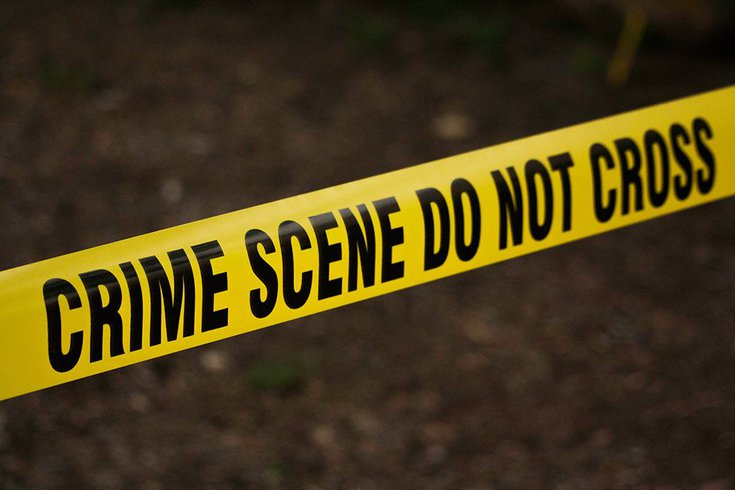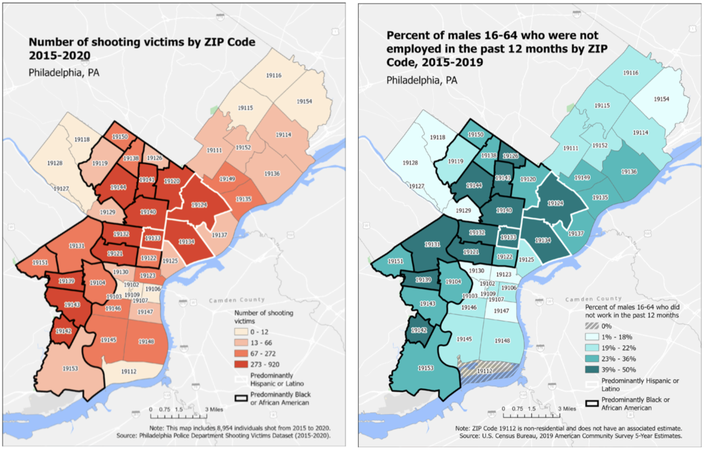
July 13, 2021
 kat wilcox/Pexels.com
kat wilcox/Pexels.com
More than 80% of Philadelphia zip codes either have high chronic male unemployment and gun violence levels or low chronic unemployment and gun violence levels.
New research from the Philadelphia Department of Public Health emphasizes the role chronic male unemployment has in the city's gun violence problem.
Zip codes with higher rates of chronic male unemployment — people ages 16-64 who have been out of work for more than one year — have higher numbers of shooting victims. At the same time, zip codes with lower chronic unemployment rates have lower numbers of shooting victims.
Dr. Ruth Abaya, the health department's injury prevention program manager and an emergency department physician at the Children's Hospital of Philadelphia, presented the data last week at the city's biweekly gun violence briefing.
More than 80% of Philly zip codes fell into one of two categories: high chronic unemployment and high gun violence levels, or low chronic unemployment and low gun violence levels.
"There are very few points of the city where one of those things is high and one of those things is low," Abaya told PhillyVoice. "I think [that] was the most telling piece that tells us there's a correlation there."
The zip codes in deep red and green mark the Philadelphia neighborhoods with the highest amounts of shooting victims and chronic male unemployment, respectively.
The zip codes with the highest chronic male unemployment — between 39-50% — had 273-920 shooting victims from 2015 through 2020. Those zip codes mostly were clustered around North and West Philadelphia.
The zip codes with the lowest chronic male unemployment — between 1-8% — each had less than 12 shooting victims over the same stretch. Those zip codes were mostly in Center City and South Philly.
There is no one cause for gun violence, though. Other factors, including poverty, substance abuse and trauma, increase the chances of gun violence and make some populations more vulnerable to victimization and perpetration, according to the U.S. Centers for Disease Control and Prevention.
Toxic stress can change brain development and chemistry in adolescents and youths, the CDC says. This stress can result from living in impoverished neighborhoods, experiencing racism and living in homes where substance abuse, mental illness and food insecurity are present.
Research from CHOP also shows that bullying prevention, gun safety and intimate partner violence prevention can reduce the risk of gun violence.
In 2020, Philadelphia suffered through its worst gun violence in years, with 499 homicides reported. And it hasn't let up. There were 295 homicides reported through Monday — up 35% from the same point last year.
A study out of Temple University, published earlier this year, found that COVID-19 restrictions have had a significant impact on the city's gun violence. The pandemic worsened poverty, unemployment and structural racism that "are empirically tied to violence in Philadelphia," the study said.
Abaya said she and her fellow researchers tracked chronic male unemployment because it showed a longer trend. Many people temporarily lost their jobs during the COVID-19 pandemic, took bereavement time or changed careers, but that doesn't point to a longer trend of unsustainable employment.
"I think that person is qualitatively different than someone who has not been able to find employment for more than a one-year period," she said.
Abaya said she hopes the study can be used to show stakeholders, anti violence advocates and health care workers that chronic unemployment is a risk factor for gun violence. Creating jobs that offer training and mentorship with the ability to be promoted will help end chronic unemployment, she said.
"Sometimes what happens is, we talk about jobs — and we need to — but we just say jobs as if it's as simple as that," Abaya said. "But I think what we need to recognize is just putting someone in a vacancy does not necessarily mean that it will not lead them to be chronically unemployed."
Philadelphia's 2022 fiscal year budget set aside nearly $5 million for workforce development through the Commerce Department, WHYY reported. It also allocated $2.4 million for a transitional jobs program.
Follow Hannah & PhillyVoice on Twitter: @hannah_kanik | @thePhillyVoice
Like us on Facebook: PhillyVoice
Add Hannah's RSS feed to your feed reader
Have a news tip? Let us know.
 Source/Philadelphia Department of Public Health
Source/Philadelphia Department of Public Health